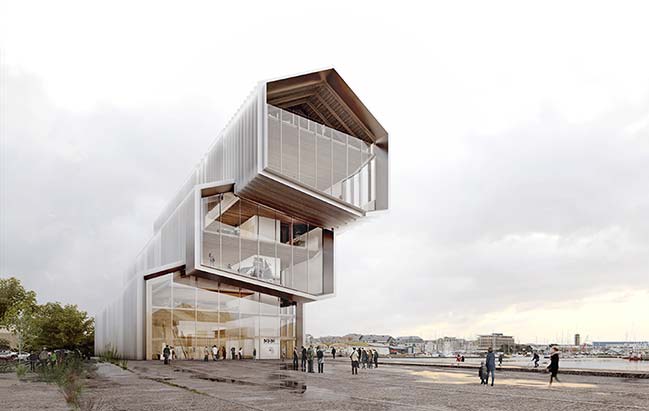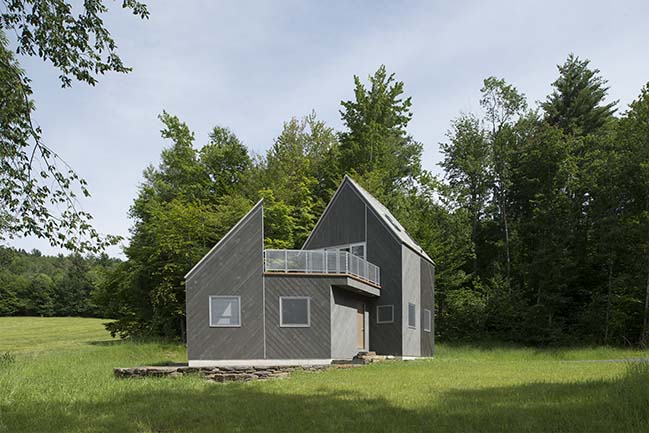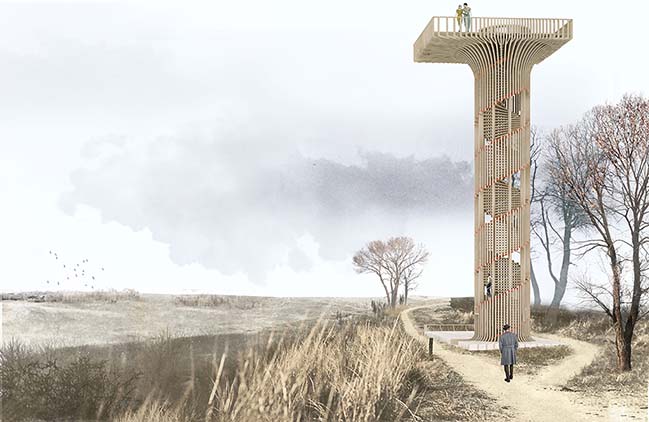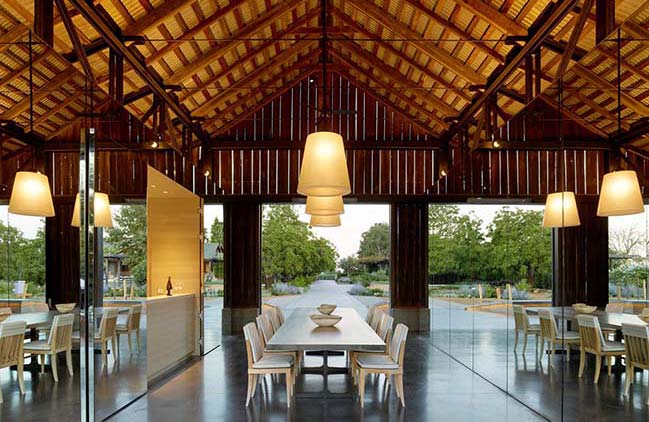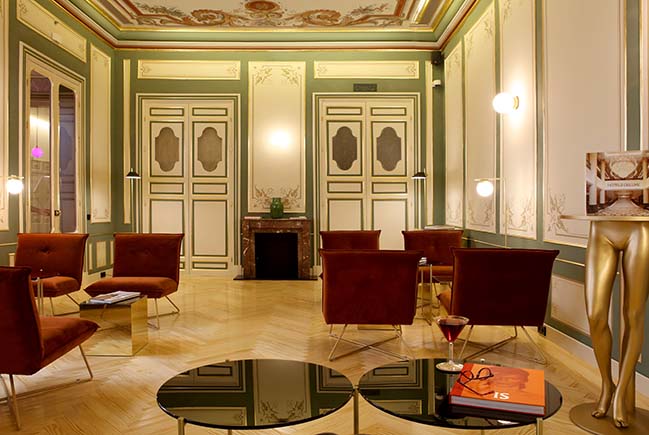06 / 06
2018
Designed by Laith Sayigh of the design studio DFA and developed by Signature Investments Group, the 300-square-foot self-sustaining structures are the preamble for a residential enclave set on 609 acres and overlooking California’s central coast.
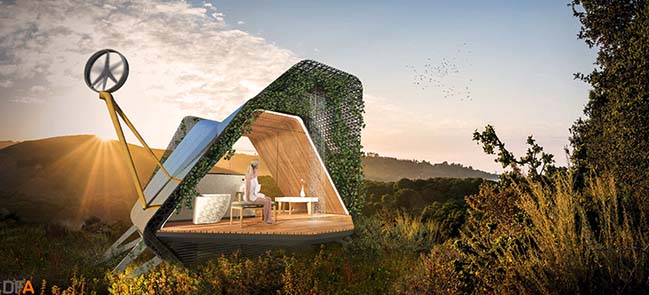
Architect: DFA
Location: Monterey, USA
Year: 2018
Size: 300 SF
Total Cost: $250,000 - $300,000
Team: DFA, Laith Sayigh, Lead Designer
Project Duration: 12 weeks total: Primary Structure 3D Printed - 4 weeks; Fit Out - 2 weeks; Delivery + Installation - 4-6 weeks
Images: DFA
From the architect: Laith Sayigh of the design studio DFA and entrepreneur Nickolas Jekogian III of Signature Investments Group, both in New York City, released the design of the Galini Sleeping Pod, a 3D-printed temporary living apparatus envisioned to introduce what more permanent living quarters within Walden Monterey’s idyllic ‘life in the woods’ setting will be like. DFA has worked alongside Branch Technologies, out of Tennessee, to develop the 3D printing Structure.
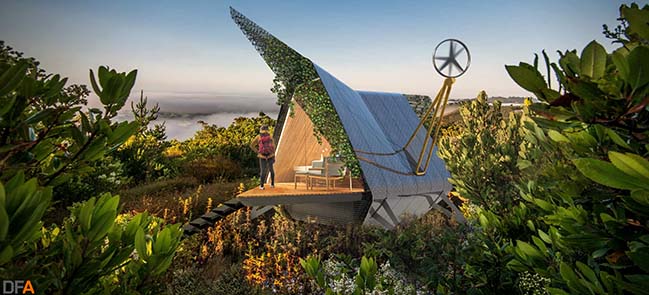
Across Walden Monterey’s 609 acres, the concept is to create a more responsible respite for people who enjoy balancing urban and rural life, minimizing their global footprint through environmentally-responsible design, and utilizing the latest in construction technology to shelter humans from the natural world. The Galini Sleeping Pod builds on DFA’s experience envisioning one-off solutions for environmentally sensitive or challenged sites, in addition to its expertise integrating urban, architectural and interior design.
In 2017, DFA released a design for a pre-fabricated 712-foot-tall Observation Tower in New York’s Central Park that would house necessary infrastructure to cleanse the Jackie Onassis Kennedy Reservoir, a contaminated body of water posing as a health hazard to human and animal life that visit the historic park.
On why he selected DFA, Jekogian explains, “When I saw DFA’s sustainable Central Park Observation Tower I knew they would fit in with the visionaries working on Walden Monterey. Within days of meeting the team we were presented with futuristic ideas for living in nature that looked like they belonged on Mars. Actually they may be on Mars someday. Walden Monterey was created for visionaries who see the value of reconnecting in nature, an approach which DFA has taken to another level.”
Responding to the client’s brief, the Galini Sleeping Pod is designed as a fully self-sustaining, zero impact structure. The 300-square-foot sleeping accommodation with shower, sink and toilet can be shipped to remote locations and placed in the landscape with very little impact on the site natural system. Four legs covering 13-square-feet in total suspend the pod off the ground allowing for plants and animals to not be displaced and exist beneath.
On why DFA explores new methods of construction in all its projects, Sayigh explains, “I am fascinated with the emergence of 3D printing structures. With the planets resources at critically low levels and the degree to which populations are exploding, traditional and current building techniques are simply not sustainable. 3D printing utilizes materials that are more abundant and more resourceful, allowing for up to—if not more than—97% material efficiency. Such gains makes projects like the Galini Sleeping Pod a viable, sustainable alternative to the future of luxury getaways and global construction.”
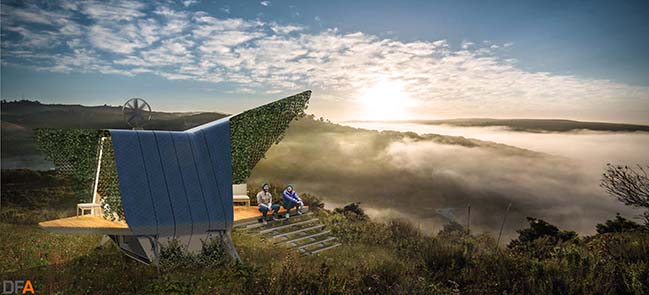
Drawing its water supply from an atmospheric water generator and recycling all wastewater by means of organic filtration, the pod has no impact on the local environment and local water table. This makes it ideal for dry and remote locations. The electrical supply is generated through the combination of both wind and solar technology. This allows for optimal collection and storage of electricity in Lithium Ion Tesla batteries.
Galini’s structure is 97% waste efficient in its construction through the use of 3D printed technology, consisting of a Carbon Fiber Infused Bio-Material that can be skinned in various materials according to needs. The pod’s secondary structural system will consist of 3,000 lbs. of recycled Aluminum, with Square extrusions and water jet/bent plates would create the mechanical unit enclosure, mechanical unit framing, louvers, mullions, stairs and footing.
Additional sustainable and low-impact systems and materials specified by DFA for the Galini Sleeping Pod include the use of Douglas Fir for exterior/interior decking, Tesla Powerwall + Tesla Solar Tiles for energy production and storage, the lightweight Honeywell WT6500 Wind Turbine measuring 6ft. in diameter and mounted to the side of the unit on top of the 3D printed frame, the Ecoblue Atmospheric Water Generator water collection and filtration system, the Ecoflo Ecological Septic System, and the Penguin II non-ducted high performance HVAC unit.
Other projects and concepts DFA has explored include the Seed Cone Pavilion, a temporary summer structure for Governor’s Island that dissolves into the landscape as a bed of native plantings; a vision for Pier 40 on the Hudson River in New York City which is designed to change function/programs by the year 2100 as a strategy for the inevitable reality of sea rise and flooding.
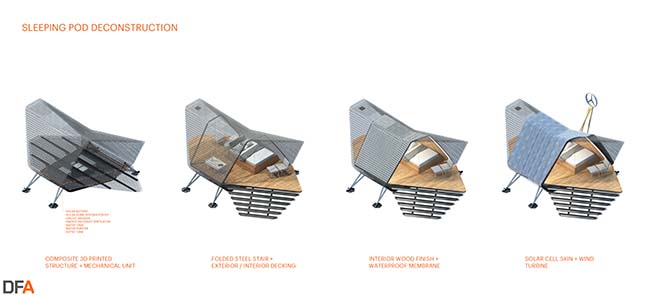
> Pier 40 2100 in New York by DFA
> MAD designs futuristic campus for Faraday Future in California
Galini Sleeping Pod by DFA
06 / 06 / 2018 Designed by Laith Sayigh of the design studio DFA, the 300-square-foot self-sustaining structures are the preamble for a residential enclave set on 609 acres...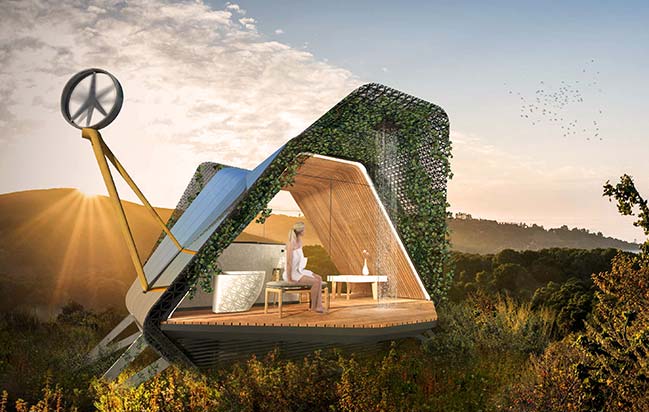
You might also like:
Recommended post: Hotel Axel Madrid by El Equipo Creativo
